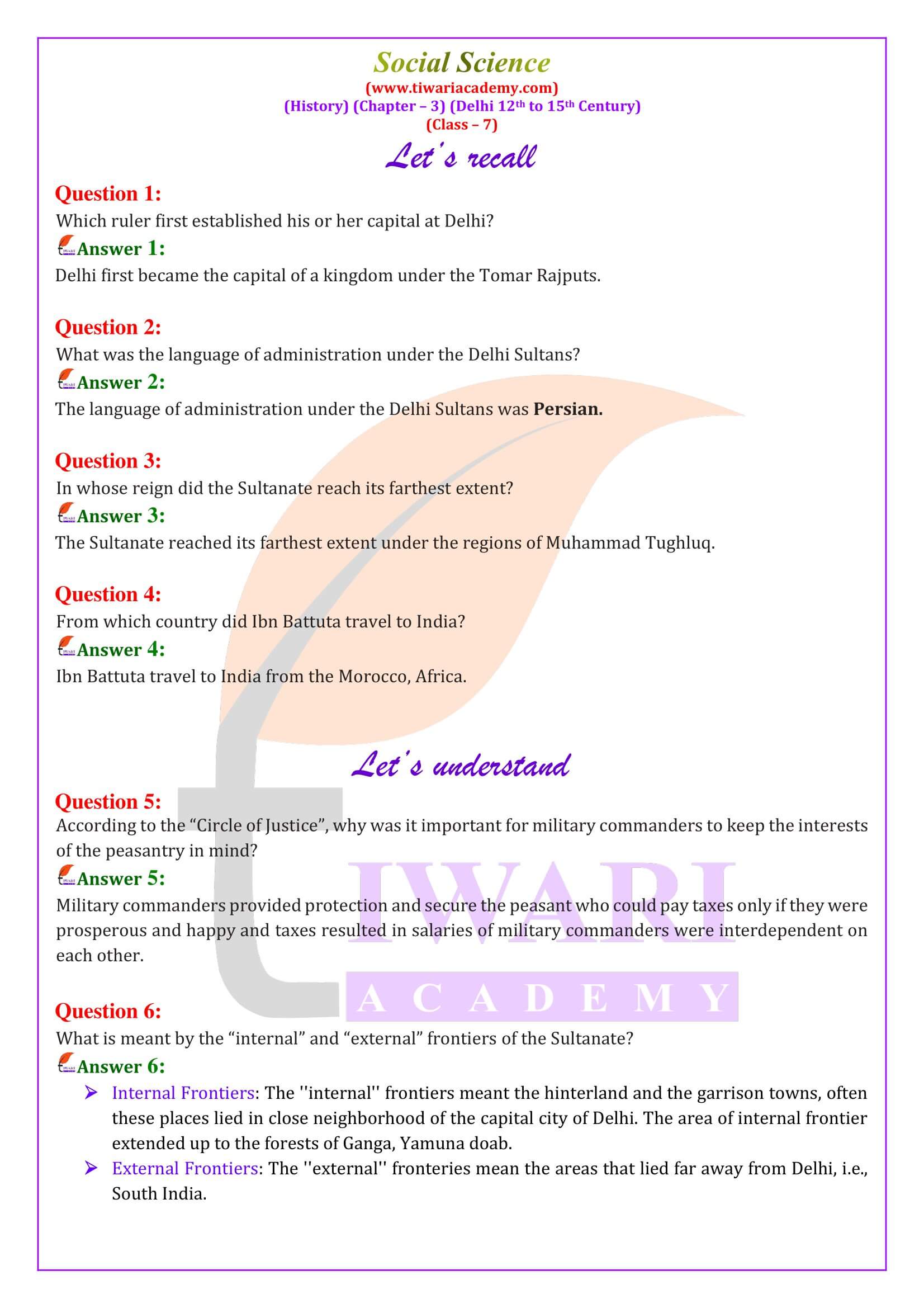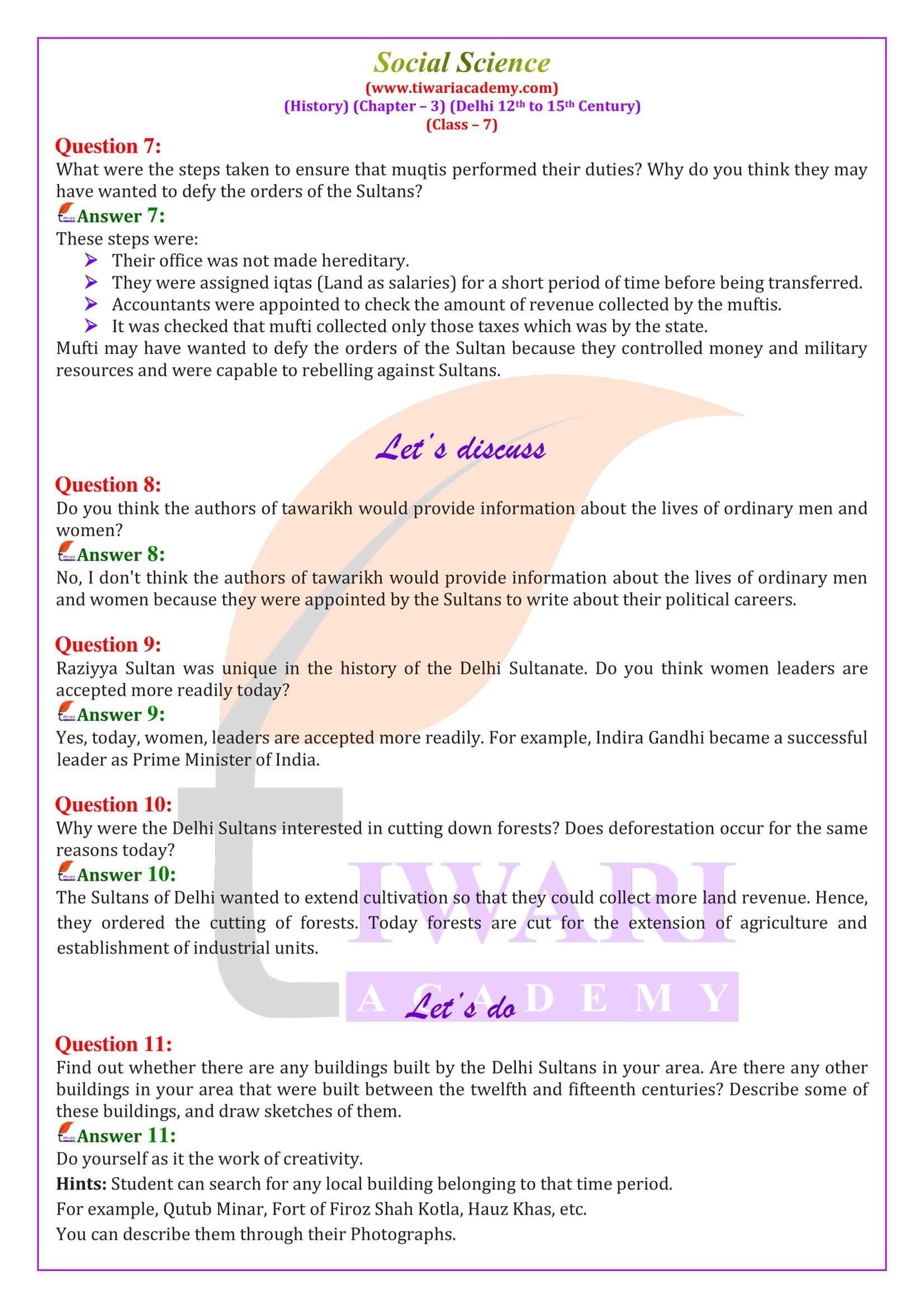NCERT Solutions for Class 7 Social Science History Chapter 3 Delhi: 12th to 15th Century in English Medium and Hindi Medium free to View online or download in PDF format updated for new academic session 2025-26. All the NCERT Solutions 2025-26 are based on latest NCERT Books for the academic session 2020–2021. NCERT Solutions Offline and Online Apps are also available on Play Store as well as App Store free to download for session 2025-26.
NCERT Solutions for Class 7 Social Science History Chapter 3
| Class: 7 | Social Science (History) |
| Contents: | NCERT Solutions with Videos |
| Chapter 3: | Delhi: 12th to 15th Century |
| Academic Session: | 2025-26 |
| Medium: | Hindi and English Medium |
Class 7 History Chapter 3 Question Answers
CBSE NCERT Solutions for Class 7 Social Science History Chapter 2 New Kings and Kingdoms, in updated format for 2025-26, is given here. Download NCERT Solutions 2025-26 and Class 7 Solutions App for new session from Play Store or App Store.
Class 7 History Chapter 3 in English Medium

Important Notes on 7th History Chapter 3
The transformation of Delhi into a capital that controlled vast areas of the subcontinent started with the foundation of the Delhi Sultanate in the beginning of the thirteenth century.
Although inscriptions, coins and architecture provide a lot of information, especially valuable are “histories”, tarikh (singular)/tawarikh (plural), written in Persian, the language of administration under the Delhi Sultans.
(1) The authors of tawarikh lived in cities (mainly Delhi) and hardly ever in villages.
(2) They often wrote their histories for Sultans in the hope of rich rewards.
(3) These authors advised rulers on the need to preserve an “ideal” social order based on birth right and gender distinctions. Their ideas were not shared by everybody.
In the early thirteenth century the control of the Delhi Sultans rarely went beyond heavily fortified towns occupied by garrisons. The Sultans seldom controlled the hinterland of the cities and were therefore dependent upon trade, tribute or plunder for supplies.
Internal & External Frontier
The first set of campaigns along the “internal frontier” of the Sultanate aimed at consolidating the hinterlands of the garrison towns. During these campaigns forests were cleared in the Ganga-Yamuna doab and huntergatherers and pastoralists expelled from their habitat.
The second expansion occurred along the “external frontier” of the Sultanate. Military expeditions into southern India started during the reign of Alauddin Khalji and culminated with Muhammad Tughluq.
The consolidation of a kingdom as vast as the Delhi Sultanate needed reliable governors and administrators. Rather than appointing aristocrats and landed chieftains as governors, the early Delhi Sultans, especially Iltutmish, favoured their special slaves purchased for military service, called bandagan in Persian.
The Khaljis and Tughluqs continued to use bandagan and also raised people of humble birth, who were often their clients, to high political positions.
Like the earlier Sultans, the Khalji and Tughluq monarchs appointed military commanders as governors of territories of varying sizes. These lands were called iqta and their holder was called iqtadar or muqti.
Class 7 Social Science – History Chapter 3 – Important Questions
Which ruler first established his or her capital at Delhi?
Delhi first became the capital of a kingdom under the Tomar Rajputs.
What was the language of administration under the Delhi Sultans?
The language of administration under the Delhi Sultans was Persian.
In whose reign did the Sultanate reach its farthest extent?
The Sultanate reached its farthest extent under the regions of Muhammad Tughluq.
From which country did Ibn Battuta travel to India?
Ibn Battuta travel to India from the Morocco, Africa.
According to the “Circle of Justice”, why was it important for military commanders to keep the interests of the peasantry in mind?
Military commanders provided protection and secure the peasant who could pay taxes only if they were prosperous and happy and taxes resulted in salaries of military commanders were interdependent on each other.
What is meant by the “internal” and “external” frontiers of the Sultanate?
Internal Frontiers: The ”internal” frontiers meant the hinterland and the garrison towns, often these places lied in close neighborhood of the capital city of Delhi. The area of internal frontier extended up to the forests of Ganga, Yamuna doab. External Frontiers: The ”external” fronteries mean the areas that lied far away from Delhi, i.e., South India.
What were the steps taken to ensure that muqtis performed their duties? Why do you think they may have wanted to defy the orders of the Sultans?
These steps were: Their office was not made hereditary. They were assigned iqtas (Land as salaries) for a short period of time before being transferred. Accountants were appointed to check the amount of revenue collected by the muftis. It was checked that mufti collected only those taxes which was by the state. Mufti may have wanted to defy the orders of the Sultan because they controlled money and military resources and were capable to rebelling against Sultans.
What was the impact of the Mongol invasions on the Delhi Sultanate?
The impact of the Mongol invasions on the Delhi Sultanate as follows: It led to military and market reforms under Alludin Khalji. A vast standing army was established under Alludin Khalji and Muhammad Tughluq to confront Mongol forces. The areas laying is north-west frontier, from where Mongol invader saw building of garrison towns and numerous strategic forts. The revenue was increased upto 50% of the produce. Soldiers were paid cash salaries instead of iqtas or land grants as salary. Muhammad Tughluq built Daulatabad, a new capital city and introduced the ”token” currency in order to mobilize resources to fight Mongol army. He also planned to invade Mongol capital in Transoxiana, but plan was aborted.
No, I don’t think the authors of tawarikh would provide information about the lives of ordinary men and women because they were appointed by the Sultans to write about their political careers.
Raziyya Sultan was unique in the history of the Delhi Sultanate. Do you think women leaders are accepted more readily today?
Yes, today, women, leaders are accepted more readily. For example, Indira Gandhi became a successful leader as Prime Minister of India.
Why were the Delhi Sultans interested in cutting down forests? Does deforestation occur for the same reasons today?
The Sultans of Delhi wanted to extend cultivation so that they could collect more land revenue. Hence, they ordered the cutting of forests. Today forests are cut for the extension of agriculture and establishment of industrial units.



